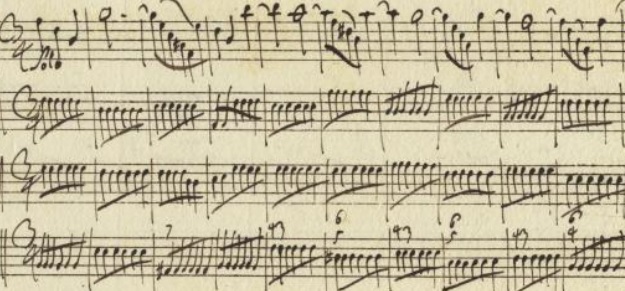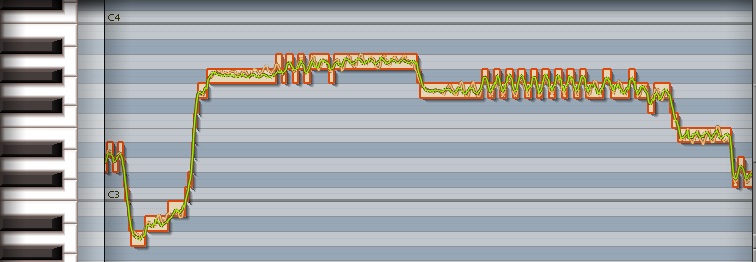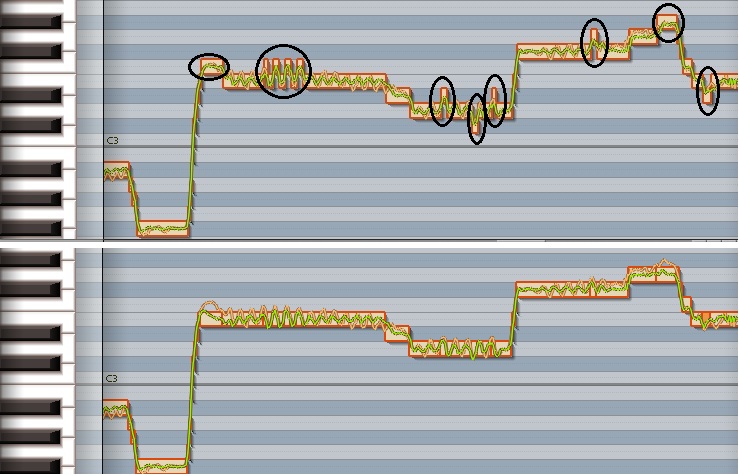Sometimes is really pays off rummaging around www.imslp.org looking at all the old manuscripts they have scanned in, many of which have not been heard since when they were written. I've spent a great deal of time making editions of Baroque music from a number of these old manuscripts and occasionally come across pure gold.
Johann Georg Thiel is an unknown 17-18th century composer who I stumbled across looking for old Baroque works to examine. I created an edition of his "Concerto for Two Trumpets in D Major" a while ago and recently thought that the Largo from this long forgotten work would be an excellent theremin piece. The Largo is a very simple chordal string accompaniment to a beautiful solo violin melody. No trumpets are used here because the movement is in B Minor and the natural (valveless) trumpets in D used in the fast movements can not play enough notes in B Minor to be melodically useful as the early trumpets were limited to playing notes from the initial part of the overtone series (which is why scales in the Baroque trumpet music you hear are all in the high register).
Perhaps you might be interested to see what the original manuscripts looked like. Here's the beginning of the piece extracted from IMSLP (for two violins, viola and cello/continuo). That bottom part, which may have been played by a viol at this point in time, has some numbers above it. This is figured bass (also called thoroughbass) that tells a harpsichord/cembalo player what "chords" to play with the bass line. Almost all Baroque chamber music has such figured bass parts and every keyboard player of the time had to be able to improvise by playing the bass and then a top part based on the chords indicated by the figures. This improvisational technique was the jazz of its time and the best continuo players could create excellent counterpoint to the other parts as well as just playing chords (ala Bach, Handel, Telemann, etc.).

Please forgive me for that aside. Well, not being able to resist the urge to "muck" with it, I adapted this wonderful piece for theremin, added an intro so you can get your initial bearings and also added a first violin counterpoint in the Baroque style as the piece is kind of bland as is (but certainly can hold up in its original form with the theremin playing the violin part if you like). I also wrote out a continuo accompaniment and left the figured bass in for those who are interested. The original can be found on IMSLP.org is you search for "Thiel" or go here.
I'll post a link to my score/adaptation below on IMSLP and I'll also post just the string .mp3 accompaniment there if anyone wants to take the plunge and try it out. The piece is a wonderful study in thirds (triadic motion with 7th chords) and especially sevenths and some octaves. The seventh is a very important interval to conquer if you want to play Baroque music as it is used all over the place, often to keep passages within a desired range (very often moving down by step after the seventh).
Sorry for the Talking Machine (I know it's overused, but it kind of sounds ok against the accompaniment). I've never really tried it that much with the Theremin though I've had one for a while, but I was wondering how it would sound through the Theremini if I use the app to set it to a filter setting that creates a complex harmonic content (Peter seemed to suggest that it sounds best on his theremin that has the most complex sound). I also ran the output through a Dave Smith DMS02 Character Module that I used to further increase the harmonic complexity of the Theremini tone that feeds the Talking Machine.
https://soundcloud.com/rk53-1/largo-thiel-kram-for-theremin-and-strings
And here's a pitch corrected version (see below for explanation) that gives a better idea of the piece.
Largo in B Minor (Pitch Corrected)
But the value of the post is really in the piece itself, which I think works very well on the Theremin (I'm practicing a version there that maybe I will post if it is acceptable as this is not an easy piece with all those jumps in there - but the harmonic simplicity helps keep you focused).
You can find the score for the piece here:
Largo (Thiel/Kram) Study Score
http://imslp.org/imglnks/usimg/9/98/IMSLP372496-PMLP554965-Thiel-Kram_Largo.pdf
The .mp3 accompaniment is here:
Largo in B Minor (Accompaniment Only)
If you are interested, the string samples used are a combination of the new Spitfire Mural string ensemble library that just came out (Spitfire is a British company making some of the best virtual instruments today). Also used a bit of LA Scoring Strings and the Vienna Symphonic Library Cembalo for the continuo. I took off most of the vibrato as you don't use it for Baroque music (at least Baroque purists like me don't).




